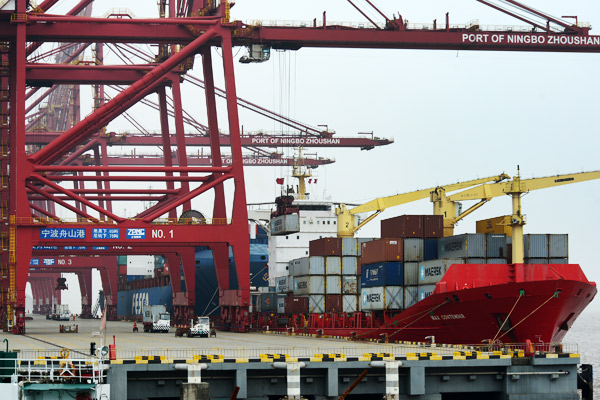Sea, river... all par for huge cargo ship's course
 |
|
A foreign ship laden with containers docks at the Dapukou wharf of Zhoushan port, Zhejiang province. YAO FENG / FOR CHINA DAILY |
Work on building China's first 20,000-metric-ton ship capable of transporting goods by both sea and river began on April 19 in the island city of Zhoushan, Zhejiang province, boosting the local free trade zone's transportation and logistics capabilities.
Zhoushan, located at the intersection of waterways of the Yangtze River and the coastline along the East China Sea, plays a significant role in water transportation.
A service center for sea-river combined transport was approved for the city by State Council in April 2016. Building vessels capable of sailing on both seas and rivers was on the top of the list.
Experts say there are great differences between seagoing and river ships. If a seagoing ship is to cruise on a river, technological obstacles need to be overcome.
The obstacles restrict transport of bulk commodities, according to Xu Quanchang, director of the Zhoushan Port and Shipping Bureau.
It was anticipated that about 60 million yuan ($8.72 million) will be invested for the construction of the first sea-river ship, around 10 percent less than that needed for an ordinary seagoing vessel.
The ship, expected to be put into use around the Spring Festival of 2018, is a forerunner of Zhoushan's plan for an entire fleet of ships for both sea and river navigation.
"This kind of ship is going to be an important boost to combined sea-river transport in Zhoushan," said Xu. "A new logistics mode will emerge here, cutting costs and improving efficiency."
He must know. For, just a day before he said that, a bulk cargo ship named Pacific Warrior berthed at the Shulanghu Island wharf in Zhoushan FTZ, carrying 389,900 tons of iron ore from Brazil worth 240 million yuan. It unloaded the iron ore on the bulk yard, which would be transferred onto the river cargo ship later.
"With the sea-river ship, we can unload the iron ore directly from the bulk cargo ship to the combined one, enhancing efficiency and decreasing waste during the transportation," said Xu.
The FTZ has identified the port and shipping industry and bulk commodity trade as key to its future.
"The throughput of Ningbo Zhoushan Port had exceeded 900 million tons in 2016, with the combined sea-river transportation reaching 200 million tons," said Wen Nuan, mayor of Zhoushan city.
The bi-functional cargo ship is expected to widen the range of the FTZ's commodity trade. In addition, construction of a second cross-sea bridge connecting the cities of Ningbo and Zhoushan in Zhejiang was approved by the Provincial Development and Reform Commission in early February.
Starting from Liuheng Island of Zhoushan, the 31-km-long bridge will reach Chaiqiao town of Ningbo. The construction will comply with the standards for highways with a maximum speed of 100 kmph. The new bridge is expected to cut at least one hour of travel time between Ningbo and Liuheng, according to the report from the province's official website.
The bridge is expected to further develop the Ningbo-Zhoushan Port by helping the Meishan Bonded Port in Ningbo to reduce storage and logistics pressures, the report said.
Meanwhile, construction of the Yiwu-Ningbo-Zhoushan corridor and the Ningbo-Zhoushan railway plan was emphasized in a government document in April, to extend and supplement the implementation of the Zhejiang FTZ strategy.









